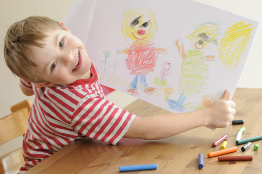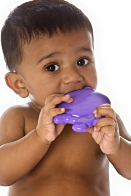Session 2
1. Session 2
1.2. Inquiry 1
Session 2: Creative Development
Inquiry 1: What Is Creativity?

© Erna Vader/iStockphoto
Watching children find delight and wonder in the world is one of the most rewarding things about working with children. What most adults consider to be ordinary, children look at in wonder and amazement. Child care providers who understand creative development will engage children and foster their sense of creativity.
Creativity is difficult to define. It is demonstrated when individuals are curious, flexible, and interested in exploring their environment. (All children have these traits.)
People using their creativity exhibit the following characteristics:
-
They think in different ways.
-
They are flexible and adapt to change.
-
They are sensitive.
-
They have a heightened awareness of the world.
-
They experience through their senses what others may miss.
-
They have a sense of wonder and enjoyment for beauty.
Creativity is taking a different or fresh approach developed from one’s own thoughts or imagination. Creativity involves a process of creating (e.g., choosing items, materials, ideas, and words to express oneself) and an end product (i.e., what is created).
For young children, the process of creating is very important. Often, their focus is on how they play with and manipulate materials. The result or end product of their creating may have little meaning to them. Sometimes there is no end product at all. There are many examples of activities that support children’s creative development but have no end product. Consider the following examples:
-
trying out diverse objects as instruments for making music
open-ended experience: an experience that allows children to choose which materials they want to use from those available, how they want to use them, and whether or not there will be an end product
Open-ended experiences do not need to include the possibility of an end product.closed-ended experience: an experience in which children are told which materials to use and how to use them
In a closed-ended experience, the end product is defined for the children. - thinking up actions to go with a song
- playing with an object in a new way
- while indoors, imagining an outdoor space in which to play camping
- telling a story to go with a picture
To develop creatively, children need opportunities to engage in open-ended experiences rather than in closed-ended experiences.
Creative Versus Factual Response
It is recommended that you ask children questions that encourage them to give a creative response. For example, a child care provider asks a child, “Why is your baby crying?” The child’s creative response might be, “She hurt her toe. A lion bit her.”
Questions that are based on facts and are either right or wrong do not develop children’s creativity. For example, “The grass is green” is a factual response to the question, “What colour is the grass?” The question does not require the child to think creatively.
While factual questions don’t require children to think creatively, they are appropriate when child care providers want to find out what a child knows. There is a place for both types of questions in a child care environment.
Checking My Understanding: Questions That Encourage Creativity
Focus
Child care providers can promote children’s creativity by asking specific types of questions. Factual questions focus more on children’s intellectual development, whereas creative questions promote creative thinking.
Directions
Complete the Questions That Encourage Creativity activity.
Stages of Creative Development
Consider the following stages of creative development.
|
Stage |
Basic Exploration |
Non-Representative |
Representative |
|
Description |
Children explore and manipulate materials by using their senses. |
Children continue to gain an understanding of materials and are able to use them with more control. |
Children pre-plan how to use materials and create something recognizable. |
|
Examples |
|
|
|

© Lichtmeister/22001883/Fotolia
When children are introduced to new materials, they may begin at the basic exploration stage. For example, toddlers may put toys in their mouths as part of basic exploration. Child care providers should understand that this is the basic exploration stage and matches the stage of intellectual development.
 Course Project
Course Project
As you progress through this session, it is important to remember that you should also be working on items and strategies to include in your strategies box. How might you apply the information presented in this inquiry to items and strategies for your course project?
Course Completion Checklist
Have you remembered to update your Course Completion Checklist? If you haven’t already started to use the checklist, access it in the Toolkit now. Remember to update the checklist every time you work on the course.